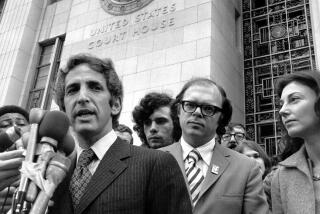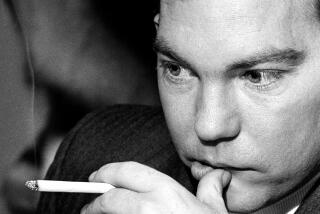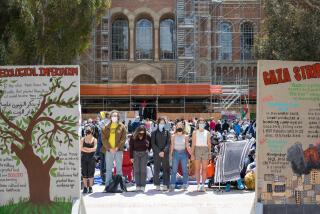The Wrong War
On this day 25 years ago, President Gerald Ford went before a crowd of 6,000 at Tulane University and announced that “the war in Vietnam is over as far as America is concerned.” The audience erupted in wild applause and, in newspapers the next day, political and foreign-affairs commentators around the country praised the president’s forthrightness. Most Americans seemed relieved that the Vietnam War had ended. Or almost ended: It would take one more week, until April 30, for Communist forces under Col. Bui Tin to accept the surrender from South Vietnamese leader Gen. Duong Van Minh.
But if Ford thought he had closed the book on Vietnam for his country, he was wrong. The book remained open, though it took a few years for most people to notice. Beginning in the late 1970s, examination of the Vietnam experience became something of a national obsession, as Americans re-fought the war in feature-length films, novels and military-oriented magazines.
Strategists began warning of a “Vietnam Syndrome,” by which they meant a basic reluctance on the part of both decision-makers and the general public to intervene militarily in unstable parts of the developing world. And indeed, the ghosts of Vietnam came up whenever the nation faced a military adventure. Nicaragua, Grenada, Panama, the Persian Gulf, Somalia, Haiti, Bosnia, Serbia and Kosovo were all seen through the lens of Vietnam.
At various points in these years, commentators have come forth to announce that “the war after the war” was over, that Americans had at last put Vietnam behind them. But they hadn’t, not fully. Today, 35 years after the start of large-scale war and a quarter century after its end, almost everything about the nation’s long involvement in Indochina remains highly controversial, even as the vast majority of Americans--and an even higher percentage of scholars--continue to believe that the war was a mistake.
Why did the war happen? Could it have been avoided? Why did the United States fail to achieve its objectives, and could victory have been achieved? And what exactly would have constituted “victory”? Consensus on these questions eludes us. Vietnam still divides America.
Perhaps it is only appropriate, then, that David Kaiser’s “American Tragedy” and Richard H. Shultz Jr.’s “The Secret War Against Hanoi” should differ so markedly in almost every way. That these books both cover Vietnam policy under John F. Kennedy and Lyndon Johnson is virtually the only thing they have in common. The narratives almost never intersect; when they do--as on the issue of Kennedy’s approach to the conflict--the authors differ dramatically in their judgments.
Kaiser’s book examines the growth of American involvement in South Vietnam, whereas Shultz is concerned with U.S.-sponsored covert action against North Vietnam. Kaiser’s Kennedy is the picture of caution on Vietnam, always reluctant to expand American involvement there, while Shultz sees him as a hawk and, in particular, an exceptionally aggressive proponent of covert action against Hanoi.
“American Tragedy” covers well-trod ground, and it ultimately suffers from not giving us enough that is new. But there is a good deal to like in it nonetheless. After giving background on American policy toward Vietnam in Dwight Eisenhower’s administration, Kaiser continues with Kennedy’s ascent to the White House in 1961 and ends the book in mid-1965, by which time Lyndon Johnson had begun sustained bombing of North Vietnam and publicly committed major ground forces to the South.
The biggest chunk of the book covers Kennedy’s thousand days, and the picture that emerges is of a fundamentally flexible chief executive who more or less single-handedly prevented America’s war in Vietnam from starting three or four years earlier than it actually did. In 1961, Kaiser argues, Kennedy had to withstand strong pressure from his bureaucracy and Cabinet members to escalate the war and send in American soldiers. The book uses recently declassified files to show that Kennedy was consistent in his opposition to the dispatch of ground troops and dubious about the possibility of maintaining public support for an American war in Southeast Asia.
Kaiser gives considerable attention to the role of Laos in U.S. policy on Vietnam, particularly in the period between 1960 and 1962. The post-1954 infusion of American aid and advisory personnel had not solidified pro-Western rule in that nation, and by the start of 1961 the U.S.-sponsored government of Phoumi Nosavan faced imminent defeat at the hands of the Communist-backed Pathet Lao.
Eisenhower, in a meeting with Kennedy the day before the latter’s inauguration, stressed the strategic importance of Laos, calling it the key to all of Southeast Asia and warning JFK that if it fell, the United States would have to write off the whole area. In the last analysis, Eisenhower advised, Kennedy should intervene militarily to prevent the forming of a coalition government including the Communists.
What should Kennedy do? Here, as elsewhere, Kaiser relies solely on American sources, especially the State Department’s “Foreign Relations of the United States” series, so one cannot regard his account as a complete history of the Laos crisis per se. Nevertheless, better than any previous study, “American Tragedy” shows the link between the Laos and Vietnam situations in the minds of senior American policymakers in the late Eisenhower and Kennedy periods. Moreover, Kaiser is correct in arguing that Kennedy’s actions on Laos in 1961--notably his decision to opt for a diplomatic rather than a military solution--show his flexibility, his willingness to go against the advice not only of Eisenhower but also of his own top aides, and his aversion to another American land war in Asia.
So far so good, but Kaiser is not content to leave it there. He denies that the Kennedy administration bears much responsibility for the coup d’etat against South Vietnamese leader Ngo Dinh Diem and his brother Ngo Dinh Nhu in early November 1963 (the brothers “had themselves to blame for their overthrow,” he writes), and he asserts that Secretary of Defense Robert S. McNamara and the Pentagon deceived Kennedy about the true military picture in Vietnam--describing it as more rosy than it was--with the result that JFK died still believing that the war effort was going well.
In these claims, Kaiser is on much shakier ground. Kennedy understood well the deepening political-military problems in Saigon in his final months; the archival record makes this quite clear. Since the summer of 1963, informed observers both inside and outside the U.S. government knew that the war effort against the Viet Cong was foundering, and that the regime in Saigon enjoyed less and less popular support.
Diem’s repressive actions against the Buddhists in 1963 represented a perfect pretext for an American disengagement from Vietnam, but Kennedy showed no interest in pursuing such a course, or in a negotiated settlement. Instead, the administration gave tacit encouragement to the dissident South Vietnamese generals plotting the regime’s overthrow; this green light from Washington was essential in leading them to act.
In his apparent desire to exonerate Kennedy’s actions on Vietnam, Kaiser also underplays the significant escalation of U.S. involvement in South Vietnam during JFK’s thousand days--from some 600 military advisors at the start to more than 16,000 at the end, with some of these authorized to take part in combat operations.
None of this means that a surviving Kennedy necessarily would have made Vietnam a full-scale American war in the way his successor did; in my view, the best argument is that he likely would have rejected such a course when push came to shove. What it does mean, however, is that at the time of his death--just three weeks after Diem and Nhu were murdered--Kennedy almost certainly still remained committed to the war, and still sought to postpone the truly difficult choices (go in deeper, or get out) for another day.
Johnson could temporize for a time, but only for a time. Eventually he had to choose, and the rest of “American Tragedy” covers the year-and-a-half during which the new president and his top aides gradually moved to make Vietnam an American war.
Kaiser echoes recent scholarship in highlighting the importance of the November-December 1964 “Working Group” deliberations in Washington, which resulted before the end of the year in a decision to begin bombing North Vietnam.
I share his view that many officials, LBJ included, from the start anticipated that ground troops would be deployed once that bombing began. As he says, numerous historians have analyzed “a two-part decision [for war]--first bombing, then troops--that never occurred. In fact, the U.S. government made a single decision for war in principle in December 1964, decided to implement it in mid-February 1965, and began the implementation in March.” Exactly right. Well before the oft-analyzed and supposedly decisive policy discussions of June and July 1965, the United States was at war in Vietnam.
*
Yet the great weakness of “American Tragedy” is its narrow field of vision. The title gives it away: This is a story about an American tragedy, not a Vietnamese or an Indochinese one.
As with so many previous books on the war, the emphasis is entirely on American decision-making. The Vietnamese, Northern and Southern, rarely appear in the narrative; in particular, policy decisions in Hanoi get exceedingly little attention.
Nor is there much here on the thinking in other major world capitals such as Moscow, Beijing, Paris, London, Tokyo or Ottawa--an especially important omission in view of the fact that, as Kaiser shows, Washington officials constantly proclaimed that maintaining American “credibility” vis-a-vis friendly and hostile governments required standing firm in Vietnam. Determining the veracity of that claim is impossible within the purely American-centered approach Kaiser uses. Nor does his approach allow for serious consideration of that other great question concerning the outbreak of war in 1965: Could it have been avoided?
Please see Page 6
Continued from Page 4
Domestically, too, the author is too restricted in his vision. Because he concentrates almost exclusively on the White House and the upper levels of the Pentagon and the State Department, he gives little sense of the mood in Congress, in the press and among the general public. As a result, we do not get any real picture of the domestic environment in which American policymakers acted in those fateful months of late 1964 and early 1965 and whether or not they had genuine options about which way to go in the war.
To be fair, it is not Kaiser’s intention to explore in depth this wider international and domestic political context of U.S. policymaking. He has produced a detailed study of how senior officials in the Kennedy and Johnson administrations approached the Vietnam issue, culminating in the major escalation of 1965. The narrow focus will frustrate many specialists, but readers wanting a sound study of high-level American decision-making on Vietnam in the first half of the 1960s will profit from getting their hands on “American Tragedy.”
They will also profit from reading Richard H. Shultz Jr.’s “The Secret War Against Hanoi,” which describes for the first time some of the covert operations the United States ran against North Vietnam during the war. Pieces of this story have dribbled out over the years, but Shultz brings them together and adds new information to tell a story that is both fascinating and depressing--though, in the latter case, not quite to the degree the author suggests.
The “secret war” fell under the jurisdiction of the innocuous-sounding Military Assistance Command Vietnam Studies and Observation Group (MACVSOG, or SOG for short). The heart of the effort involved psychological warfare, or “psywar,” which was intended to confuse and demoralize the enemy.
Among other gambits, SOG inserted some 250 secret agents into North Vietnam over a period of 3 1/2 years and oversaw commando raids against the northern coast. Navy reconnaissance teams also were sent across the borders into Laos and Cambodia to call in airstrikes along the Ho Chi Minh Trail, the vital supply route used by Hanoi to get men and materials into the South. Sometimes the teams also contaminated rice caches along the trail, rendering the rice so inedible that even the maggots wouldn’t touch it.
And there were other schemes. The secret warriors created radio stations to broadcast propaganda, for example, and were not deterred when they realized that few North Vietnamese had radios--they simply smuggled in the radios as well.
In one of the more interesting parts of the book, Shultz describes how SOG went so far as to create a phony resistance movement in North Vietnam called the Sacred Sword of the Patriots League. To start with, clandestine radio broadcasts were made announcing the movement’s existence, and leaflets were scattered over North Vietnam describing its activities. Then, in order to give the movement foot soldiers, North Vietnamese fishermen were kidnapped, blindfolded and taken to an island off the coast of South Vietnam, where the United States had created a phony North Vietnamese village supposedly “liberated” from Hanoi’s rule.
After three weeks of “training,” the fishermen were blindfolded again and returned home, in the hope that they would spread the word that there existed a liberated zone in the North. About 1,000 North Vietnamese were kidnapped in this way between 1964 and 1968. SOG officials hoped that rumors of a genuine opposition group would strike panic into the Hanoi leadership.
But Ho Chi Minh and his colleagues did not panic easily, and therein lies one of the problems with this book. Shultz tries to show that Hanoi became very concerned about these various covert operations, particularly by 1967-’68, but he does not convince.
He states in the introduction that he gained access to more than 4,000 pages of previously classified SOG documents, but few of these are actually cited in the book. Many of Shultz’s claims about the secret war’s impact on the North either have no apparent documentation to back them up or are drawn from interviews with former SOG officials who are not in a position to have known Hanoi’s thinking.
For Shultz, it appears, as for the SOG operatives he writes about so admiringly, the story of the “psywar” is a depressing tale of Washington higher-ups continually blunting the promising efforts of the secret warriors. But one must ask: How promising were they? Not very, it seems.
It is more likely that the program’s many skeptics in the CIA and the Pentagon were correct: Covert action against the North was never going to yield much in the way of results and therefore didn’t deserve high priority in the war effort.
Shultz quotes approvingly the claim by a former secret warrior that the United States should have worked hard to set up a resistance movement in the North that would have been a “parallel to” the Viet Cong in the South; this was never in the cards, nor could it have been--the Hanoi government’s internal position was too secure, as Shultz’s own account demonstrates. (If anything showed the security of Hanoi’s position, it was this: Not one of the 250 agents SOG inserted into the North ever returned. All were either killed or turned into disinformation agents by Hanoi.)
Future release of now-classified material may tell us more, and Shultz is to be commended for giving us this first look, but for now one must conclude that it’s a story more interesting than important.
Then there is Kennedy’s role in all of this. JFK is a key figure in “The Secret War Against Hanoi,” and he comes across as a boldly assertive advocate of the covert war against North Vietnam from his first days in office until the end in Dallas. From the start, Shultz asserts, Kennedy was impatient to get going on the secret war, and he grew frustrated because he felt that his demands for action were not being met.
Here again, however, Shultz seems to draw his conclusion from slight evidence, mostly one or two fleeting remarks made by Kennedy during a policy discussion in late January 1961. Shultz has not misread these remarks, necessarily, but he has exaggerated their import. On such a weak foundation, the edifice becomes shaky.
It’s not that Shultz is wrong in arguing that Kennedy had a fascination with covert action; he did. The problem is that the author does not come close to demonstrating that JFK was obsessed with implementing such action against Hanoi or that he was angered by the inaction of underlings. Shultz sees no evolution in Kennedy’s thinking, but Kaiser’s book and other recent literature presents good evidence that the president became more and more of a skeptic on Vietnam as time went on--not to mention more and more determined to keep it from overshadowing other foreign policy issues.
The Vietnam experience will continue to divide Americans for at least as long as the present generation of Washington leaders remains in power. Scholars will conduct more research because the conflict is, by historical standards, very recent. But if there is still much to be learned, at least one thing seems clear. The books by Kaiser and Shultz confirm, explicitly or implicitly, something that many Americans have felt deep in their bones since the day those first Marines landed near Da Nang 35 years ago: This war was the wrong war, in the wrong place, at the wrong time. It was a lost cause that swallowed millions. That is why its ghosts haunt us still.
More to Read
Sign up for our Book Club newsletter
Get the latest news, events and more from the Los Angeles Times Book Club, and help us get L.A. reading and talking.
You may occasionally receive promotional content from the Los Angeles Times.








